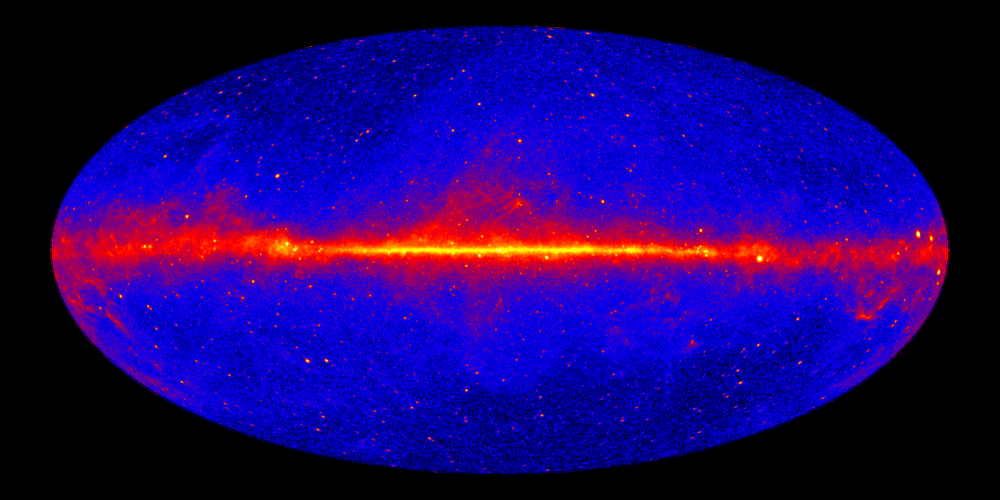The Fermi-LAT collaboration has published its fourth source catalog, named 4FGL. Based on eight years of data, it contains 5064 celestial objects emitting gamma rays at energies around 1 GeV, adding more than 2000 high-energy sources to the previous collection (published in 2015). More than one fourth of the objects are of unknown nature, calling for numerous follow-up studies. Although its volume is modest compared to the billions of sources listed in optical catalogs, the 4FGL catalog is by far the deepest in gamma-ray astronomy and serves as a reference to the entire domain. The catalog, coordinated by a researcher at the Astrophysics Department (AIM Laboratory) of CEA-Irfu at Paris-Saclay, is accessible on line at the NASA Fermi web site. In parallel, the 4LAC census of active galactic nuclei (coordinated by a researcher at CNRS/CENBG) is also made available to the community.
Fermi is a NASA satellite launched in June 2008, which carries the LAT (Large Area Telescope), a wide field telescope collecting gamma rays from 30 MeV to 1 TeV. It surveys the sky every three hours since August 2008. This continuous survey results in a catalog of sources provided to the scientific community, now at its fourth update called 4FGL. More than two thousand sources were discovered since the previous catalog (3FGL) published in 2015. This improvement was made possible by doubling the observing time (8 years for 4FGL), understanding the detector better (Pass 8 data), improving the analysis methods, and modeling at higher resolution the interstellar emission of our Milky Way, which forms a complex background (see figure below) from which individual sources are difficult to sort out.
The catalog provides for each source its localization, its energy spectrum, its temporal variability (common) and its counterpart at other wavelengths when it can be found. Most sources (62%) are blazars, giant black holes at the center of faraway galaxies whose powerful jets of particles point toward us (making the jets much brighter). A smaller fraction (5%) is made of pulsars, magnetized neutron stars rotating very fast, with a period less than one second, down to a few milliseconds. An even smaller fraction (3%) is shared between other types of sources located in our Milky Way including supernova remnants, which are suspected of accelerating the cosmic rays producing the interstellar emission. Add a drop (2%) of other extragalactic sources, radio and starburst galaxies. The rest (28%) could not be associated to known objects, partly because the catalogs of counterparts are not deep enough, and because of confusion in the disk of the Milky Way. New types of sources are probably lurking among those unidentified sources, but it is difficult today to tell them apart from the commoners.

Fermi sky map cumulating 10 years of observations at energies between 1 and 100 GeV, in Galactic coordinates. The color scale is logarithmic, from dark blue to yellow. The Milky Way corresponds to the horizontal red and yellow bar. It shines brightly in gamma rays because of nuclear interactions between the cosmic rays and the interstellar gas. The isolated red and yellow « dots » are the individual sources of gamma rays listed in the catalog. Credit: Fermi-LAT collaboration
This work has already been cited 150 times and will be, like the three previous catalogs, a starting point for many follow-up studies. The first of those is the 4LAC catalog of the 2863 active galactic nuclei detected by Fermi, detailing their emission over the entire electromagnetic spectrum from radio waves to gamma rays. Another application is the search for new pulsars, which can be set apart from blazars based on their curved spectrum and very weak variability. In a few years, the Fermi-LAT catalog will be the main pool of targets for the Cherenkov observatory CTA, currently in construction, which will detect gamma rays at even higher energies (around 1 TeV).
The LAT telescope keeps working and the results are regularly updated. The first incremental 4FGL catalog (Data Release 2) covers 10 years of data and is now on line at the NASA Fermi Science Support Center. The two additional years of observations allowed finding some 700 new gamma-ray sources. Most are close to the detection limit, but a few are very variable blazars whose jet became active over the last two years. The next incremental catalog (DR3) will cover 12 years of observations and should be available in early 2021. In the longer run, the Fermi group at Saclay keeps improving the model of interstellar emission in order to increase the reliability of faint sources in the Milky Way. The LAT telescope has no identified successor to this day. It will be hard to beat!
Contact CEA: Jean Ballet, Isabelle Grenier
Publication :
« Fermi Large Area Telescope Fourth Source Catalog », Abdollahi et al 2020, ApJS 247, 33
Acces to pdf article : https://arxiv.org/abs/1902.10045
Main authors: Jean Ballet (CEA Saclay; coordinator and gamma-ray analysis), Toby Burnett (Washington University at Seattle, USA; source detection), Seth Digel (Stanford Linear Accelerator Center, USA; model of interstellar emission), Benoit Lott (CENBG Bordeaux; association with radio and optical catalogs). This work has been supported by CNES.
Collaboration : Fermi-LAT (USA, Italy, France, Japan, Sweden)
See also :
The CNRS/IN2P3 press release (in french)
The Fermi NASA website
Le site FERMI du DAp (in french)
NASA’s Fermi Satellite Celebrates 10 Years of Discoveries (June, 2018)
Record mondial de citations pour le catalogue Fermi (10 janvier 2013, in french)
Bestiaire gamma, parution du premier catalogue des sources Fermi (Juin 2010, in french)
Rédaction: Jean Ballet, Isabelle Grenier
• Structure et évolution de l'Univers
• Institute of Research into the Fundamental Laws of the Universe • Department of Astrophysics (DAp) // UMR AIM
• High Energy Cosmic Phenomena
• Fermi
